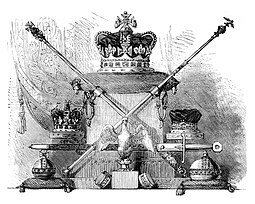Crown of Frederick, Prince of Wales
| Crown Jewels | |
|---|---|

St Edward's Crown (top) is used to crown the monarch. It is flanked by the sceptres. Also in this picture are the crown and diadem of Mary of Modena (wife of James II of England), the blunt Sword of Mercy, the eagle-shaped ampulla, the armills, and the orbs.
|
|
| Overview | |
| Country | United Kingdom |
| Location |
Jewel House and Martin Tower at the Tower of London Debating chambers at the Palace of Westminster |
| Size |
140 objects:
|
| Oldest | Coronation Spoon (12th century) |
| Newest | Queen Elizabeth II's Armills (1953) |
| Stones | 23,578 |
| Owner | Queen Elizabeth II in right of the Crown |
| Managers | Martin Swift (Crown Jeweller) Royal Collection Trust Historic Royal Palaces |
| Website | www.hrp.org.uk |
140 objects:
The Crown Jewels of the United Kingdom, originally the Crown Jewels of England, are 140 historic royal ceremonial objects, including the regalia and vestments worn by kings and queens of the UK at their coronations.
A symbol of 800 years of monarchy, the sovereign's coronation regalia is the only working collection in Europe – other present-day monarchies have abandoned coronations in favour of inauguration or enthronement ceremonies – and is the largest set of regalia in the world. Objects used to invest and crown the monarch variously denote his or her roles as Head of State, Supreme Governor of the Church of England, and Commander-in-Chief of the British Armed Forces. Wives of kings are crowned as queen consort with a plainer set of regalia. Since 1831, a new crown has been made specially for each queen consort.
Use of regalia by monarchs in England can be traced back to its early history. A permanent set of coronation regalia, once belonging to Edward the Confessor, was established after he was made a saint in the 12th century. By the Tudor period it was usual for monarchs to inherit state regalia from his or her predecessor. Most of the present collection as a whole dates from around 350 years ago when King Charles II ascended the throne. The medieval and Tudor regalia had been either sold or melted down by Oliver Cromwell, a republican who overthrew the monarchy in 1649, during the English Civil War. Only four original items pre-date the Restoration: a late 12th-century anointing spoon, which is the oldest object in the collection, and three early 17th-century swords.
...
Wikipedia
